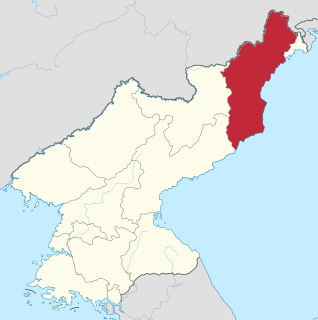This article relies largely or entirely on a single source .(June 2016) |
Komusan 고무산 | ||||||||||||||||
|---|---|---|---|---|---|---|---|---|---|---|---|---|---|---|---|---|
| Korean name | ||||||||||||||||
| Hangul | 고무산역 | |||||||||||||||
| Hanja | 古 茂 山 驛 | |||||||||||||||
| Revised Romanization | Gomusan-yeok | |||||||||||||||
| McCune–Reischauer | Komusan-yŏk | |||||||||||||||
| General information | ||||||||||||||||
| Location | Komusal-lodongjagu, Puryŏng, North Hamgyŏng North Korea | |||||||||||||||
| Coordinates | 42°07′01″N129°41′47″E / 42.1169°N 129.6963°E Coordinates: 42°07′01″N129°41′47″E / 42.1169°N 129.6963°E | |||||||||||||||
| Owned by | Korean State Railway | |||||||||||||||
| Line(s) | Hambuk Line Musan Line | |||||||||||||||
| History | ||||||||||||||||
| Opened | 1917 | |||||||||||||||
| Electrified | yes | |||||||||||||||
| Services | ||||||||||||||||
| ||||||||||||||||
Komusan Station is a railway station in Komusal-lodongjagu, Puryŏng, North Hamgyŏng province, North Korea. It is the junction point of the Hambuk and Musan lines of the Korean State Railway. [1] [ page needed ]

Puryŏng County is a kun, or county, in North Hamgyŏng province, North Korea.

North Hamgyong Province is the northernmost province of North Korea. The province was formed in 1896 from the northern half of the former Hamgyong Province.

North Korea, officially the Democratic People's Republic of Korea, is a country in East Asia constituting the northern part of the Korean Peninsula, with Pyongyang the capital and the largest city in the country. The name Korea is derived from Goguryeo which was one of the great powers in East Asia during its time, ruling most of the Korean Peninsula, Manchuria, parts of the Russian Far East and Inner Mongolia, under Gwanggaeto the Great. To the north and northwest, the country is bordered by China and by Russia along the Amnok and Tumen rivers; it is bordered to the south by South Korea, with the heavily fortified Korean Demilitarized Zone (DMZ) separating the two. Nevertheless, North Korea, like its southern counterpart, claims to be the legitimate government of the entire peninsula and adjacent islands.
The station was opened in 1917 by the Chosen Government Railway, at the same time as the rest of the Ch'ŏngjin-Hoeryŏng section of the former Hamgyŏng Line; from 1934 to 1940 it was managed by the South Manchuria Railway. The station was destroyed during the Second World War; after the Korean War, it was refurbished with Soviet and Chinese assistance.

The Chosen Government Railway was a state-owned railway company in Korea under Japanese rule. It was a department of the Railway Bureau of the Government-General of Korea, whose functions were the management and operation of railways in Korea, as well as the supervision of privately owned railway companies.
Ch'ŏngjin Ch'ŏngnyŏn Station is the central railway station in Ch'ŏngjin-si, North Hamgyŏng Province, North Korea. It is the junction point of the Hambuk Line and the P'yŏngra Line of the Korean State Railway, and is the beginning of the Ch'ŏngjinhang Line to Ch'ŏngjin Port.

The South Manchuria Railway, officially South Manchuria Railway Company, or 滿鐵 for short, was a large National Policy Company of Japan whose primary function was the operation of railways on the Dalian–Fengtian (Mukden)–Changchun corridor in northeastern China, as well as on several branch lines. However, it was also involved in nearly every aspect of the economic, cultural and political life of Manchuria, from power generation to agricultural research, for which reason it was often referred to as "Japan's East India Company in China".






